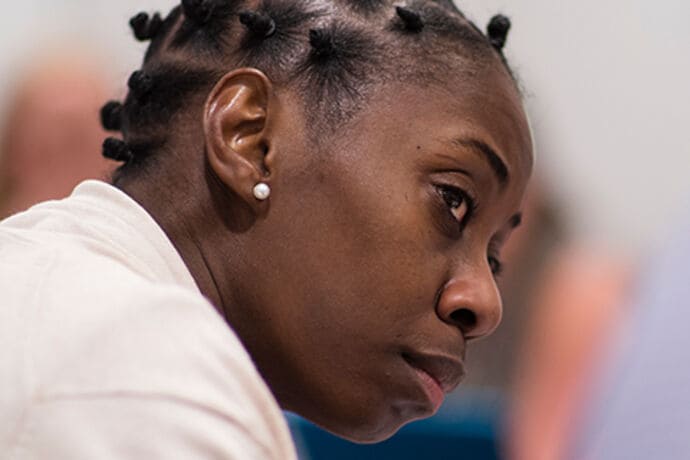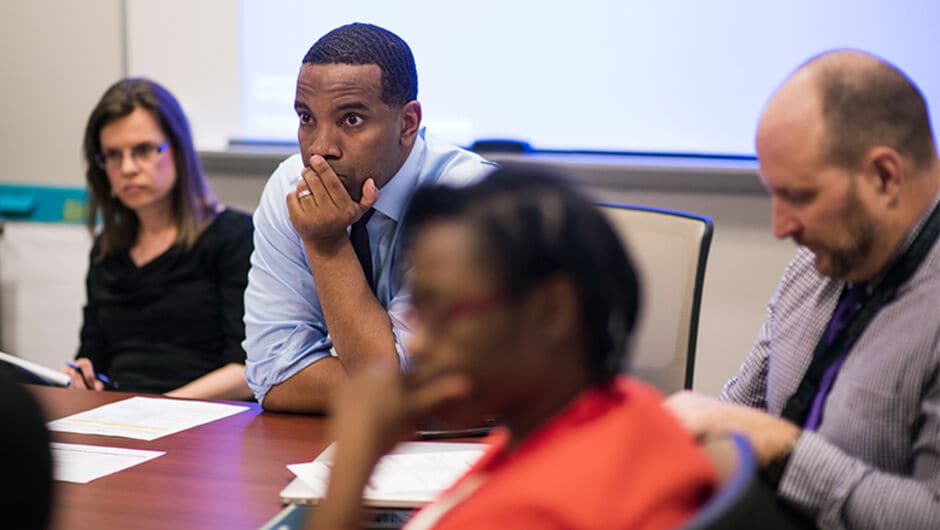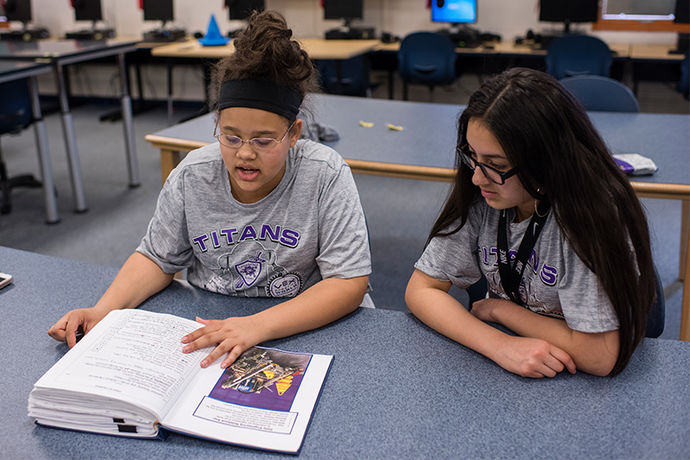
Rebuilding Schools in a Rust Belt Town
Residents of Lorain, Ohio, defend its rich history and community spirit, while outsiders hear only about its missteps and failures. As a new leader steps in, students weigh in.
Count up every person in every city in the U.S. with 100,000 or more people and you’ll have just over a quarter of the nation’s population. That means that roughly 38 million school-aged children live someplace that isn’t a Chicago or an L.A., where a spotlight shines on school districts’ every innovation or setback. These students—by far the majority—live in places where, to the rest of the nation, their education is practically invisible. Lorain, Ohio (population 64,000), 30 miles west of Cleveland on the shores of Lake Erie, is one of those places. Before the Rust Belt started rusting, Lorain supported up to 80,000 people on the strength of its mighty steel, auto, and shipbuilding industries. It proudly claimed the title International City, a nod to the many ethnic communities drawn to its abundance of jobs, including Hungarians, Czechs, Puerto Ricans, and African Americans leaving the South. (Nobel laureate Toni Morrison grew up in Lorain in the 1930s and 40s; her father worked in the steel mills.)
Beginning in the late 1970s, Lorain’s economy slid downhill, and by 2010, the bottom had fallen out. Shipbuilding had disappeared, the Ford auto plant stood nearly vacant, and the steel mills, whose smokestacks and warehouses stand like a ghost town for nearly three miles along Lorain’s Black River, settled into silence. About 20 percent of Lorain’s peak population had left the city in search of jobs elsewhere, leaving empty homes, empty storefronts, and an unemployment rate topping 13 percent.

David Hardy (Miami–Dade ’03) had barely heard of Lorain before he applied a year ago to become the CEO of its school system. He knew only that the system was in big trouble. Five superintendents had cycled through in eight years, leaving teachers and principals with institutional whiplash. Twenty-six percent of third graders could read at grade level. Fewer than 20 percent of eighth graders scored proficient or higher on state ELA tests. By graduation, only 1 percent of juniors and seniors were prepared for college without remediation.
In 2013, Lorain’s school system was listing so badly that Ohio’s education department put the district under the oversight of an academic distress commission. But student outcomes barely budged. So last year, backed by a new law, the state installed a new distress commission and simultaneously stripped the elected school board of nearly all of its power. Out of 37 applicants to right the ship, the commission chose Hardy.
On a recent spring day, Hardy wore jeans and a light blue sport coat over a tight-fitting Lorain Titans T-shirt that hinted at his morning routine: He does daily reps in the high school gym before anyone but the custodians arrive. Hardy grew up as an academic and athletic standout in West Chester, Pennsylvania, earning a scholarship to Colgate University, where he studied economics and started as point guard for its Division I basketball team. Once, he nearly scored a layup against Carmelo Anthony until Anthony rejected that ball into the bleachers (students love that story).

Hardy taught middle school in Miami before becoming founding principal of Achievement First East New York. He then moved into central office positions in Philadelphia and Camden, New Jersey. As the deputy superintendent in St. Louis in 2014, he oversaw that district’s return to full academic accreditation.
Over a lunch of pastelillos at Mi Casa, a Puerto Rican café in Lorain where Hardy has become a regular, he said there’s a disconnect between the pride the community takes in its schools and those schools’ student outcomes, which are among the worst in the state. But he knows the pride isn’t misplaced—at least on the surface.
At Longfellow Middle School, giant banners celebrate a robotics team with dozens of championships to its name. The high school spring musical, accompanied by an award-winning band, attracted a near-sellout crowd. The high school itself is new, designed to look like a college campus with full-sized basketball courts and career-tech classrooms that resemble state-of-the-art factory floors. The state didn’t take over the district because the district had failed at everything, Hardy says, but because it had failed at its primary purpose, to educate all kids well.
Lorain schools have faced foundational shifts in their student body in recent years, too. Nearly all students qualify for free or reduced-price lunch, compared to 73 percent of students in pre-recession 2006. Enrollment has fallen by more than 2,000 students over that time, to about 6,700. The proportion of students of color has grown, while the teaching force has stayed largely white. At the same time, district leaders made some bad calls, Hardy says. “It’s been death by a thousand pinpricks. One bad decision multiplied by another bad decision and another.”

Historical complications piled up. In 1979, the local chapter of the NAACP filed a complaint alleging patterns of segregation and discrimination in Lorain schools. A 1984 consent decree led to the creation of an ambitious magnet program, including a bilingual school for Spanish-speaking students and one of the state’s first public Montessori programs. The efforts succeeded at integrating the schools, but as schools needed more money to support the salaries of added teachers and programs, the city earned less of it. The innovative schools shuttered. In 2007, the district laid off a third of its teaching staff to address massive financial debt. In 2012, 182 more school employees lost their jobs.
Rae Bastock grew up in Lorain and graduated from Lorain City Schools. For the past 23 years, she’s been an educator there, most recently as the principal of Southview Middle School. “The missing piece has been an educational vision,” Bastock says. There have been pockets of success, like the junior ROTC program and career tech classes, but they thrived on their own, away from the revolving door of superintendents. With each leadership change, “whoever the previous superintendent was, it was like everything that person did was wrong and needed to be thrown out,” she says.
“Teachers have been left on their own. And when what they’re doing doesn’t work, there’s been no support,” Bastock says. “It’s hard to have high expectations in that kind of environment.”
Nearly every week since he started the job, Hardy has met with groups of students. They are brilliant, he says, but reveal a strain of defeatism. “There’s a sense that ‘this is the best we can do.’ That ‘no one’s ever expected us to do more than this, and maybe a little less,’” he says. But if Lorain is to find renewal, its students need to help lead the way, he says. “I truly do believe they’ve never been given the option or awareness that they can do, and be, and demand something better.”

Hardy has used his Teach For America friendships strategically. He met LaKimbre Brown (Phoenix ’99) at summer institute, and they went through Teach For America’s School System Leaders Fellowship together in 2013. When he called her in late summer 2017, she was one of D.C. Public Schools’ most veteran instructional superintendents, coaching principals and overseeing results at 12 elementary schools.
Brown agreed to visit Lorain on what she thought would be a one-week consultancy. But when she arrived, she found none of the chaos she expected from a state-takeover district. Instead, what Brown found struck her as almost too simple. Lessons were boring. Packets of worksheets a half-inch thick, or one-off projects found on the internet, passed as a curriculum. Hardy had commissioned the nonprofit TNTP to report on the curriculum teachers were using. Just 17 of the 94 lessons TNTP reviewed were aligned to state standards, and none of those were at the middle or high school level.
“And the kids [were] sitting there quietly taking this!” Brown says. She couldn’t help thinking that if she and the rest of Hardy’s team could just bring some rigor to the curriculum, students would happily rise to the challenge. “This doesn’t just feel doable,” she recalls thinking. “This is really winnable.”
During her exhausting week of consulting and interviews, Brown began to feel an energy she wasn’t expecting. She’d planned to sleep on the airplane ride back to D.C. “But my heart was racing—I couldn’t rest,” she says. “I wrote [Hardy] the longest letter about what that week meant for me, and I said, ‘Let’s do this.’”
By this past May, Hardy, Brown, and their team had hired “turnaround principals” for each of the district’s 14 schools, the majority of whom already worked in the district. Each school is also hiring two deans, one for academics and one for scholar and family engagement. Once each leadership team is in place, Brown says the academic planning for next year will begin in earnest. She’ll set up many of the same structures that worked for her in D.C. and were largely non-existent in Lorain, like regular meetings with her principals and deans, coaching them on how to develop excellent teachers.
Hardy has been on the job for almost one year of his five-year commitment (a three-year contract that the academic distress commission can renew for two additional years). “It’s flying,” he says. “Every layer we peel back, there are three more layers.”

Of all his goals, he is most excited about reorganizing the high school experience. His big bet, and a centerpiece of the strategic plan he’s calling the “Lorain Promise,” is to see all students, by 2022, graduate from high school with either an associate degree or a professional certification. It feels particularly pressing in a city like Lorain, he says, where the top growth industries—food service and retail—pay only about $12 an hour, and the emerging, better-paying local companies, like chemical and aerospace manufacturers, require highly skilled workers.
By the time today’s Lorain 8th graders are in 10th grade, they’ll begin to choose courses from five overlapping pathways. Students in Early College classes will earn credits from Lorain County Community College. The Advanced Placement path will offer a college-prep curriculum. A STEM and Career pathway will offer career-tech courses, some of which also provide college credit. Civic Engagement will include political science, social justice, and law courses. And Performing Arts will include music, theater, and public speaking courses. As ninth graders, students will sample from each of the pathways.
Hardy has several degrees, including one from an elite liberal arts university and one from an Ivy League graduate school. They mark expertise, but they’re also his armor, he says. “As a black man in this job, I feel I’m constantly trying to prove myself. When I’m able to articulate the degrees I have, I feel more comfortable.” He wants the same for his students—some sort of a shield against the low expectations that have dogged them for years. He says, “I need to provide kids with reasons not to make excuses.”
In this city that is often overlooked, we spoke with kids and their parents. Their future—and the future of their city—depends in part on whether Hardy is able to deliver on his promise to reimagine the high school experience to provide them with rigor, inspiration, and belief.
Paul Robertson
Eighth grader Paul Robertson is all limbs and smiles, with a burst of black hair that adds 6 inches to his athletic frame. Energy escapes him like steam from a teapot, finding its way through tapping toes and dancing fingertips.

He loves basketball and science, reading and Red Lobster. “I used to like outer space—a lot—when I was younger. I would bug my parents: ‘Do you know what the Milky Way is?’ They probably did know, but I would tell them anyway.”
At 1 year old, Paul was speaking in full sentences, astounding his parents, Rochelle and Paul Sr. By 2, he insisted on being out of diapers. By 4, he was reading. “Paul didn’t want to take the extra steps other kids had to take,” Rochelle says.
In fifth grade, in Mr. Hernandez’s class, he could hardly wait for the annual Predator vs. Predator project. Mr. Hernandez assigned Paul and his partner to the polar bear vs. the grizzly bear. But his partner barely showed up. “I had to do the work for him. I really hate when people slack.”
Paul’s parents grew up together in Lorain in the 1980s. When Paul Sr. was 13 years old and Rochelle was 15, she gave birth to Paul’s older sister. They dropped out of school and found work, sharing child care. When Rochelle turned 18, they found their own place and have been together ever since, going on 27 years.
Rochelle earned her GED and is now attending Lorain County Community College, pursuing a degree in criminal justice. But Paul Sr. has worked in local factories since he was a child, surviving one dying industry after another. Rochelle says of Paul Sr., “He tells Paul, ‘I stand on my feet and work day in and day out on hard concrete. If you don’t have a degree, this is what you get.’”
In sixth grade, Paul started to struggle with writing. “I felt like I had a flaw. I don’t like having flaws,” he says. So in seventh grade, he sought extra help from his English teacher. It has paid off, he thinks. He applied this year for Ohio State’s Young Scholars Program for first-generation college students. If accepted, he’ll be guaranteed a spot at the university with a hefty financial aid package, as long as he completes a rigorous high school curriculum and maintains a high GPA.
But while Paul has been able to succeed, he’s watched close friends who have never quite found their footing, he says. One friend recently received a suspension for a non-violent infraction. (Paul was reluctant to share details that could bring unwanted attention to the student.) Even more than providing rigorous coursework, Paul has asked Lorain Schools CEO David Hardy to rethink how schools dole out punishment.
“I hate to have people suspended. They don’t learn anything,” he says. He mentions that his friend’s home life has been challenging this year. “I don’t know how days off school would help. He’s hurting.”
Paul dreams of leaving Lorain, ideally as a first-round NBA draft pick. But if that doesn’t work out, he hopes to pursue sports medicine and become an athletic trainer. Until then, he has four years of high school to complete. He likes the sound of graduating with an associate degree, particularly because it’ll allow him to take college-level coursework, like the kind he helps his mom with at home.
“I like to learn a lot,” he says. He bursts into a string of facts he learned from a YouTube video about exoplanets, like that winds there reach 25,000 miles per hour. “Think about the Earth spinning 25 times faster. Everything would be different. Everything.”
Hardy’s response: “The third commitment of the Lorain Promise is to promote equity. A big part of that is moving toward a culture of care and community, where staff are supported in putting love and joy at the center of the classroom and in interactions with all kids.”
Jada McCall
A seventh grader at Lorain’s Longfellow Middle School, Jada McCall loves her hometown. It’s where her Puerto Rican great-grandfathers put down roots in the post-WWII era, after manufacturers recruited them and thousands of their fellow islanders to work in the steel mills and at the Ford Motor plant. (To this day, Lorain has one of the largest Puerto Rican populations per capita in the U.S.) It’s where Jada’s parents grew up and attended school, where her dad’s cousin became the first African American journalist at the local newspaper, and where her sister was crowned Lorain International Queen as part of the city’s annual International Festival.

At Longfellow, Jada is a member of one of the best middle school robotics teams in Ohio. On a recent spring afternoon, stretching into the evening, Team Titanious tinkered with its robot, Tank, weeks before their final competition. The team’s goal was to maximize the 18-inch tall machine’s speed and accuracy as it scooted around a 12-foot by 12-foot platform “field,” moving in and out of obstacles and stacking small construction cones.
Jada sat apart from the mechanized mayhem. Her job, with her best friend, Karen Gallegos, was to scout competitors’ results and to fill the team’s giant engineering notebook, more than 2 inches thick, with every single step of the robot design process. Tank started with brainstorming in August and ended in April with its final code—itself 45 pages long. Each team’s engineering book serves as proof at competitions that the robot is their own creation, not a teacher’s or an overzealous parent’s.
To look through the engineering book is to see Jada’s and Karen’s patience with details. Every change and performance result has been captured in neat, handwritten notes. Jada dreams of studying forensics in college and becoming a crime scene investigator, like the heroes of her favorite show, Criminal Minds. She hopes the meticulous record keeping she’s developed through robotics will serve her well.
Melissa McCall, Jada’s mom, believes in David Hardy’s plan to transform Jada’s high school experience. But she is less concerned about what field Jada pursues and more concerned that she’s able to pursue her chosen career in Lorain. She has watched families move elsewhere in search of better schools, or enroll their children in a nearby district or at a parochial school. “Jada’s father and I chose for our kids to remain in the district,” she says. “I’d much rather they go to an integrated school where they see kids with their ethnic background.”
But for Lorain to remain viable, McCall knows the school system must succeed. “I worry most about our teachers,” McCall says. After years of leadership changes and declining student outcomes, “they’re emotionally and financially worn out.”
In April, Jada’s robotics team attended the VEX Robotics World Championships in Louisville, Kentucky, where they placed 26th in the “skills” category out of 183 teams. At the state championship in March, the team took home the award for overall excellence. Their success gives Jada’s mother hope.
“I hope and pray for the day things do come back to Lorain. Maybe it’s not the steel mills booming again, but tech companies or other investments,” she says. “So that our families can stay closer to home.”
Hardy’s response: “We have a Herculean task in showing our teachers how much we care about them, how much we value their work, and how much we want to support them. The most important thing we can do is to give power to our teachers and leaders to do right by kids.”
Vianka Vega
On a spring morning, junior Vianka Vega stood facing a whiteboard, working out a trigonometry problem in front of a sleepy second-hour class. Black curls fell over her shoulders onto a Lorain Titans T-shirt, printed on the back with “No Excuses, No Days Off.” She completed the problem with one teacher assist, then returned to her textbook (copyright 1983) and a review packet for the upcoming midterm.

This semester is Vianka’s second shot at trig, which she needs to pass with at least a B to stay in a program that will provide her a scholarship to Ohio State University. So she squeezed it into her schedule at the same time as a health class, meaning she earns her health credit as a sort of independent study.
She failed trig the first time because she couldn’t pass the tests. But at a deeper level, it’s hard to say if she failed because the content was too challenging or because it wasn’t quite challenging enough to hold her attention.
“She’s very smart—all my kids are,” says Moraima Vega, Vianka’s mother. But when it came time for the test in eighth grade to determine which select group of kids could take the early college track in high school, Vianka didn’t pass it. So while she dreams of attending medical school, she’s stuck with a course load that often bores her.
“I would like to be more challenged,” says Vianka, who has advocated to Hardy for the high school to provide true college-prep material, even for students who can’t take the early college track. More than her own high school experience (she only has one year left), she thinks of her younger siblings: brothers who will be in 9th and 10th grade in the fall, and a sister who will be in 5th grade. “I would like for them to have more than we had.”

Vianka and her siblings grew up 30 miles away in Cleveland, where she learned early to tackle challenges. When Vianka was eight, Moraima left an abusive boyfriend and started working 10- to 12-hour days as a regional manager of a Rent-A-Center. Vianka took over parenting duties, helping her siblings with homework and dinnertime. “She was the adult in the house,” Moraima says.
Then in 2013, Moraima’s husband died of a heart attack following heavy drug use. It was a wake-up call for her life, which had started to spiral out of control, Moraima says. So she picked up her family and moved to Lorain for a fresh start.
For Vianka, in seventh grade, it was a good move. Her bubbly, social personality proved a good fit for a tight community. Her grades improved. She joined cheerleading and track. This spring, she started working as a hostess at the local Applebee’s, saving money for college and a car.
Tackling challenges is Vianka’s greatest strength, Moraima says. She recalls a recent evening when Vianka came home from work and gushed about how much she loved the pace and the multitasking. “It exhilarates her to learn everything, to know she’s getting it.”
When her senior year begins in the fall, Vianka will have access for the first time to Advanced Placement courses—Hardy has promised four at the high school in 2018-19: English, Statistics, U.S. History, and Environmental Science.
Moraima, who dropped out of school when she became pregnant with Vianka at 18 years old, completed her remaining high school credits in September, at the same time as she was completing successful treatment for cervical cancer. She hopes to start taking courses at Lorain County Community College in the fall.
“In my house, no one says, ‘I can’t do that.’ It’s not accepted,” Moraima says. “Because when they get older, they won’t have a choice.”
Hardy’s response: “After four new AP courses next year, we’ll increase by at least two per year going forward. Students deserve rigorous coursework. We need to give them opportunities to showcase their brilliance.”
Sign up to receive articles like this in your inbox!
Thanks for signing up!
Content is loading...


